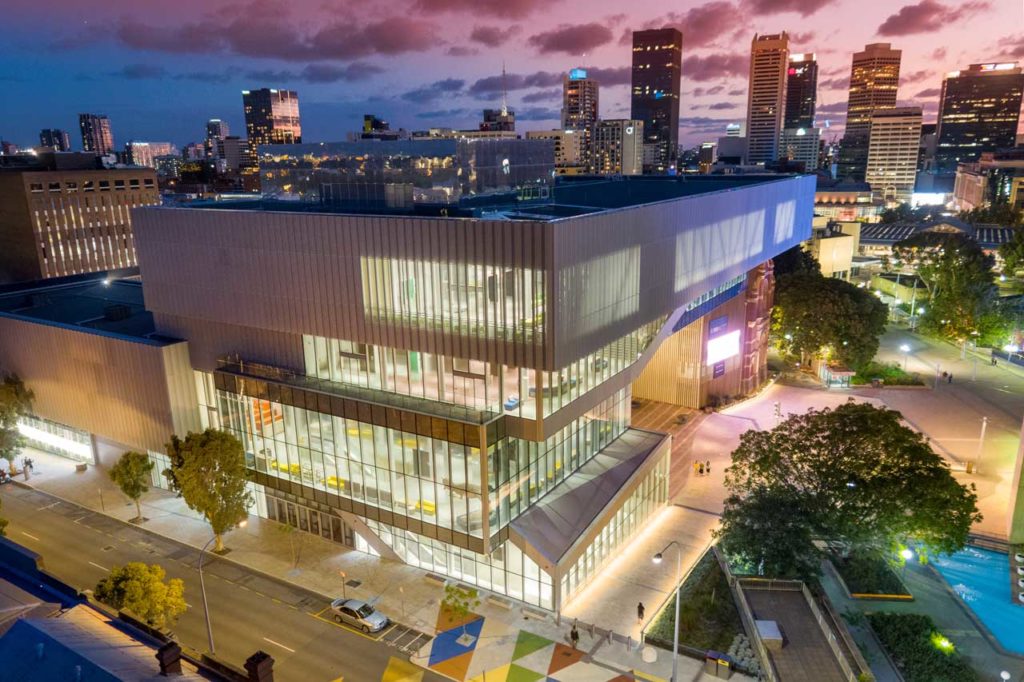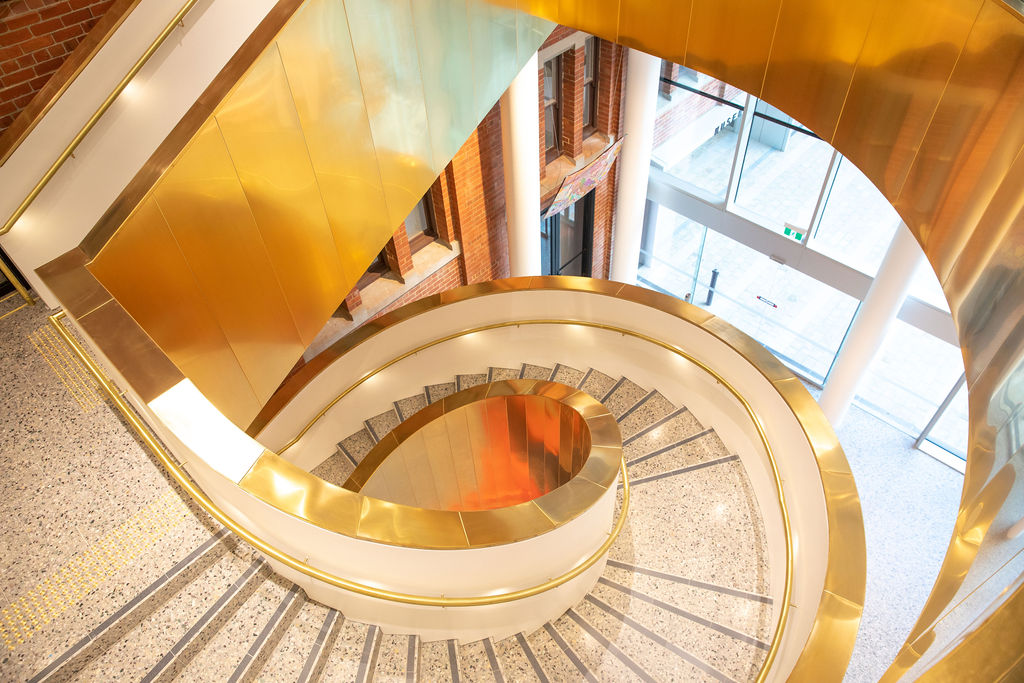The Rising Star of
Sonya Edney
Who is Sonya Edney?
Sonya Edney is an Ingarrda-Wadjarri artist born in Carnarvon in the Gascoyne region of Western Australia in 1974. Sonya started painting at Burringurrah community, located between the towns of Meekatharra and Carnarvon.
What is Sonya Edney famous for?
Sonya's first solo exhibition launched at Japingka Gallery in 2019. Her work generated the most rapid sales of any exhibition in Japingka's thirty-year history. This was highly unusual for a first-time solo exhibitor. The universal appeal of Sonya's work attracted interest from Australian and international art collectors. Her popularity has continued in solo exhibitions in 2021, 2022, 2023 and 2024. Sonya's work has also since gained attention with high profile projects like the WA Museum exhibit (see below) and the 2023 spectacular drone show, First Lights — Nyinggulu at the drone show at Cardabia Station, as part of the Dark Sky Festival in Exmouth during the time of the Total Solar Eclipse.
What is Sonya Edney's connection to the WA Museum Boola Bardip?
In 2020, the Western Australian Museum reached out to Sonya Edney to propose a partnership for a new, permanent exhibition. The Origins exhibition would be a collaboration with Edney's art, working it into a cultural and scientific history of the universe. The multi-media presentation featuring Sonya's painting Seven Sisters is one of the most popular exhibits in the museum.
Sonya Edney at The Origins Gallery, WA Museum Boola Bardip
One of the most popular galleries in the new WA Museum Boola Bardip is Origins - Land, water, sky. This gallery display includes a large multi-media presentation featuring a painting, Seven Sisters by Sonya Edney. In this interview with Sonya Edney, she talks about having her work featured in the museum and what that experience has been like for her.
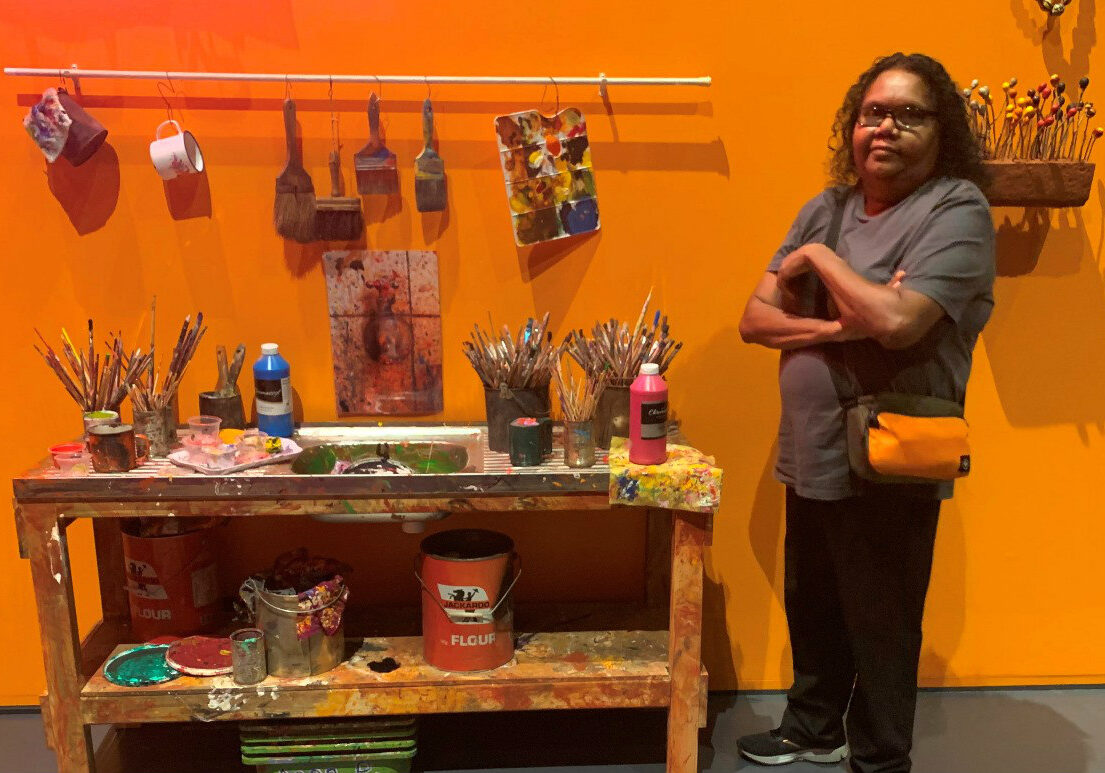
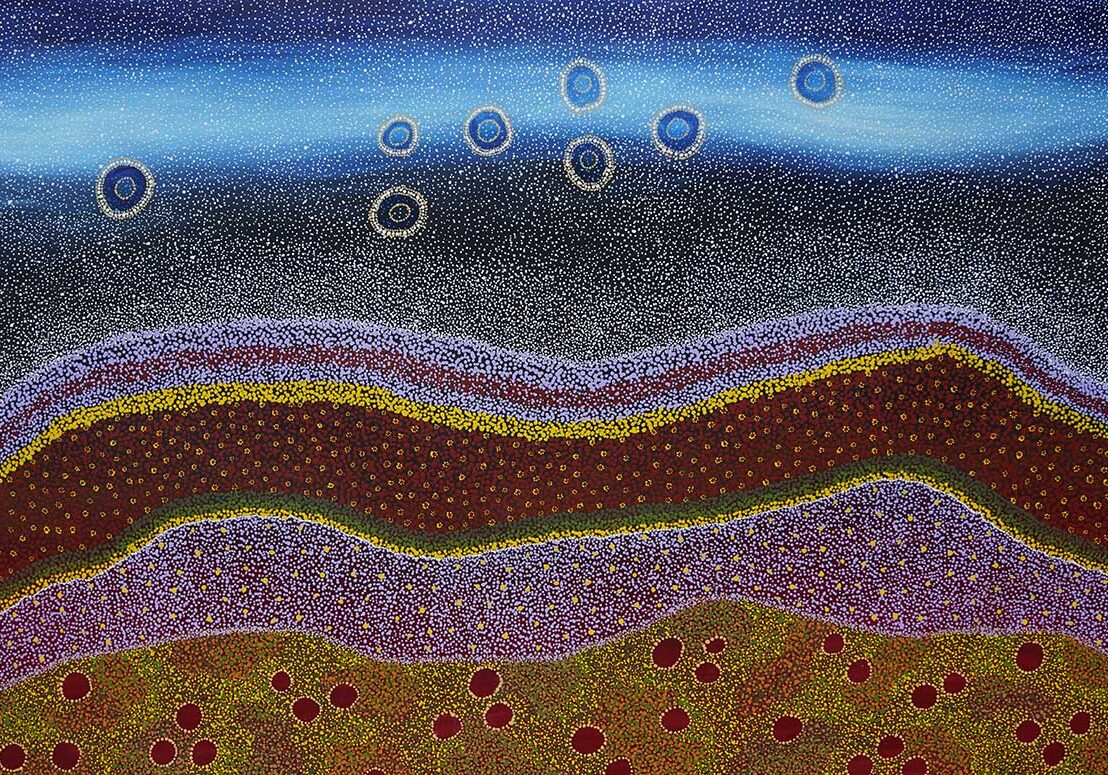
Sonya Edney talks about the WA Museum Boola Bardip
How did you feel when you found out that the museum team were interested in one of your works?
I felt really excited. Then I wondered about what they were going to do with the image.
Can you tell me what it was like when you saw the presentation for the first time?
I felt proud. I felt emotional, and I had tears in my eyes. I was just surprised by how they put it all together. I had tried to visualise how they were going to do it. When I saw it, I was like, oh, yes, they did do it like what I was imagining they were going to do with it.
Was there any aspect of it that surprised you?
Yes, I was surprised to see how they created so much free movement.
How did you feel seeing it today?
It feels good. I saw it briefly last year when it first opened. It’s great to see it again and take it in.
How do you describe it to the people in your family that haven't seen it before?
I just tell them it’s about the stars and the sky forming into my painting, and then it starts moving.
Have you met people who have seen your work in the Origins Exhibition?
My sister came down, and she really liked it. She got emotional seeing my work and told me she felt proud of me. She was really, really proud. I mean, she's seen me paint all my life, but it is very different seeing something like this in the museum. It is so big, and it has a special meaning for us. The museum chose my painting, Seven Sisters, and there are seven sisters in my own family.
... it has a special meaning for us. The museum chose my painting, Seven Sisters, and there are seven sisters in my own family.
Have you met anyone else who's seen how your work is used in the museum?
Yes. Some other people walked past me and said, "Hey, I've just seen your artwork in the museum. I reckon it's deadly," they said.
Is there a message you’d like to send to the team who worked on the Origins gallery?
I want to say thank you for creating something like this for everyone to see because it makes the painting feel even more alive. When people see it in 3D with all the movement, it creates a very different feeling. I love what they’ve done.
Alec Coles
Chief Executive Officer of the Western Australian Museum
As well as the new WA Museum Boola Bardip, Alec is responsible for a number of West Australian Museums including: the Museum of the Great Southern, Museum of Geraldton, Museum of the Goldfields, WA Maritime Museum and the WA Shipwrecks Museum in Fremantle.
Alec discusses the Museum’s approach to Aboriginal representation at the new museum Boola Bardip, the very popular Origins gallery and his response to seeing Sonya’s Edney’s artwork in the multi-media presentation highlighting the Seven Sisters story.
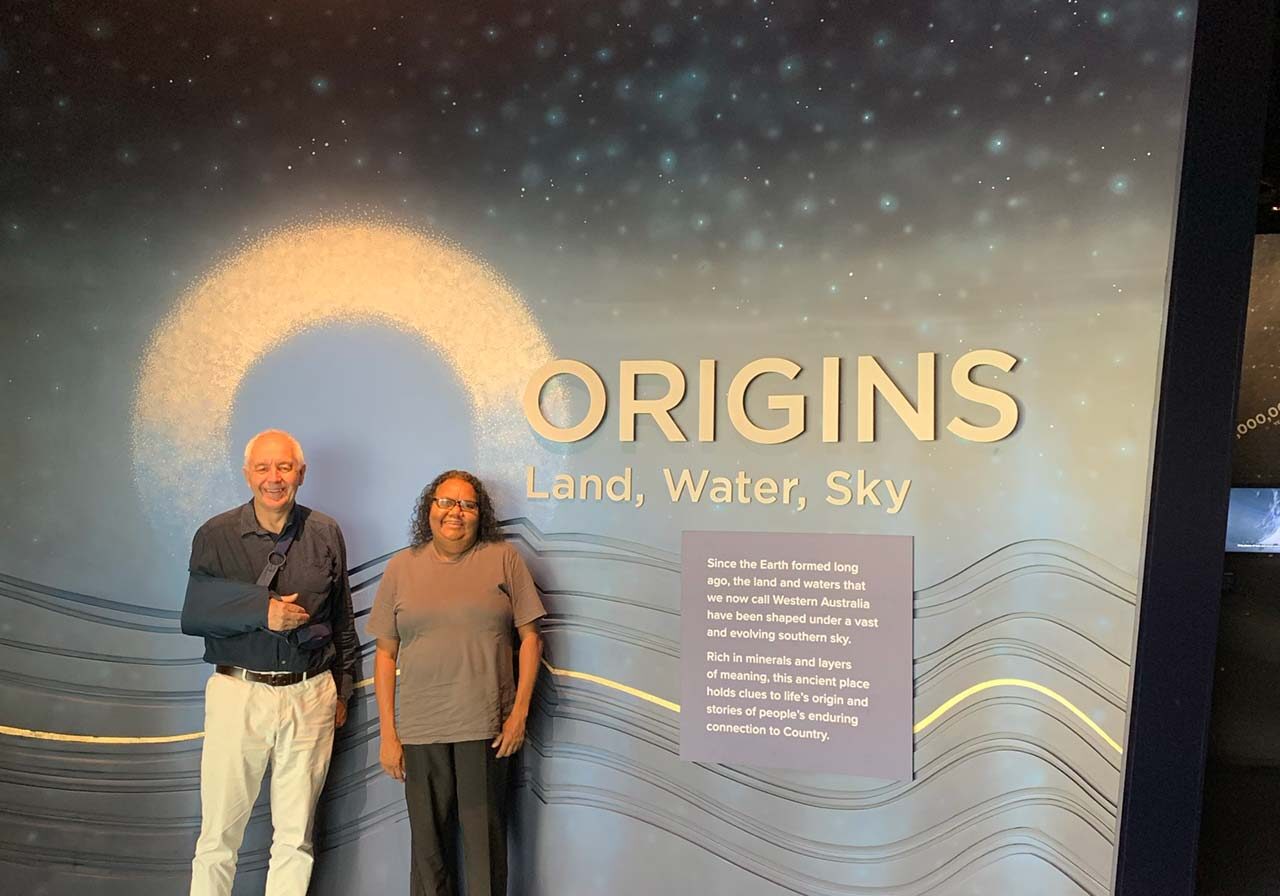
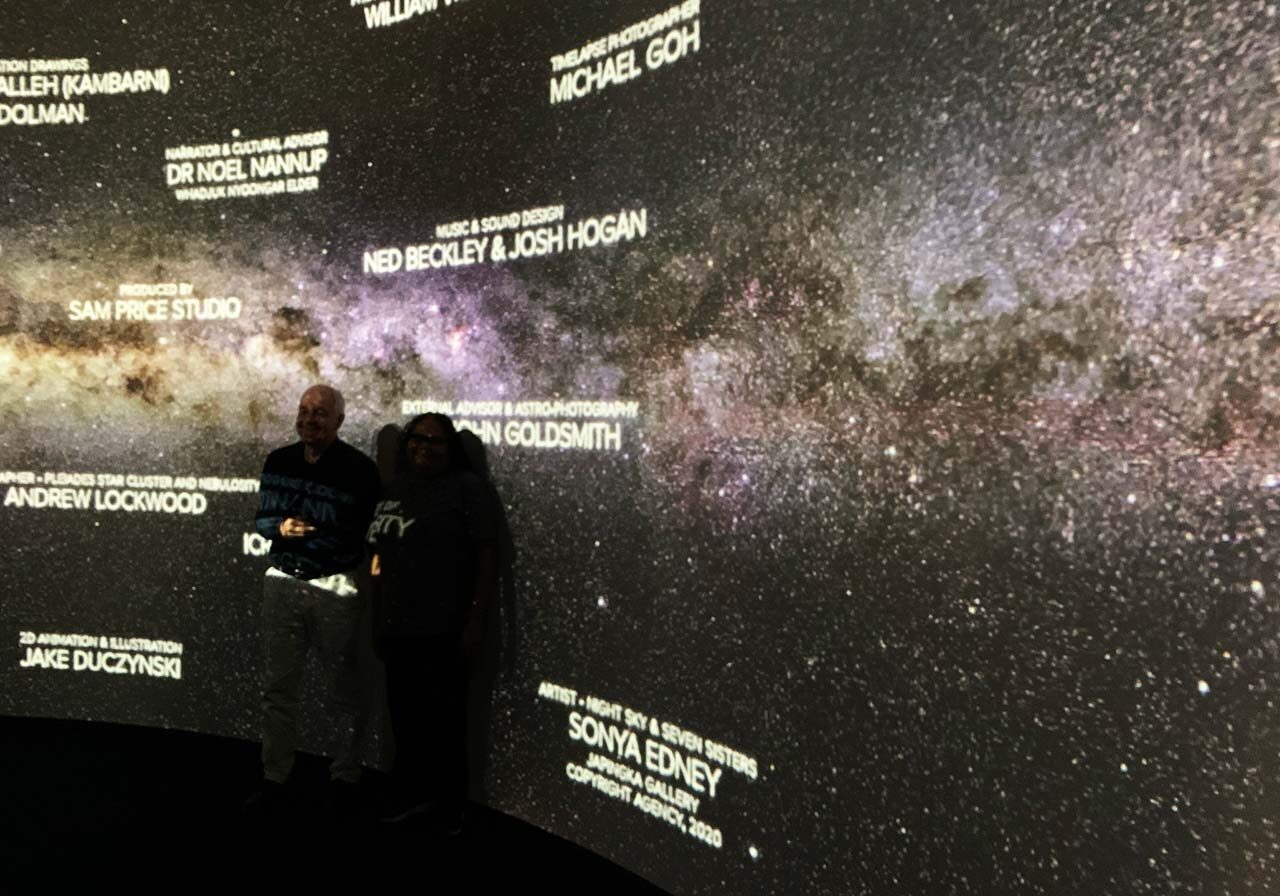
Can you tell me about how the new museum planners approached Aboriginal representation?
It was a very early commitment that we would ensure that Aboriginal voices and perspectives would be represented throughout the whole of the museum. For this reason, although there is one gallery specifically dedicated to Aboriginal cultural materials and stories – Ngalang Kort Boodja Wirn (Our Heart, Country, Spirit, in Nyoongar)- you will find Aboriginal content, voices and expression throughout the whole museum. This was driven by our principle that we would try not to speak for people who could speak for themselves.
Right now, we are standing outside the Origins gallery, which features Sonya Edney’s work. That gallery is just one example of many that shows examples of how we've approached storytelling, using real voices and authentic works of art and artefacts. In the first two months, since our opening, we have had a quarter of a million people through the Museum. It's been an extraordinary success and I'm delighted. I think the thing that has warmed me most has been a very wide acknowledgement by a whole range of people, including a lot of Aboriginal people, that those voices are represented throughout.
People have commented on that as being something that defines this museum building, Boola Bardip. For me personally, and all the staff who've worked on this project, that was always our priority. In the planning and creation of this project, we spoke to over 50,000 people, not just Aboriginal people, but people right across Western Australia. We've worked with about sixty different language groups. These days, seeking out the voices of real people has become second nature. In the end, we forgot that this isn't normal practice for many museums. I think the fact that that has been recognised so widely is something that fills me with a lot of pride.
Do you think this approach will influence other planners?
I think many people have a strong desire to work this way and there are already fine examples of their work. Having said that, I think that the way that it is manifest here, and the degree to which it has been recognised and commented upon, means that hopefully, even more people will have the confidence to approach their redevelopments, or their programs, in a similar way.
How would you describe the Origins Gallery to someone who hasn't seen it yet?
It's such an exciting gallery and I describe it in various ways. From a Western perspective, it's about the history of the Universe, from the big bang right up to the most innovative technologies that are exploring the universe today. What makes it so interesting is that it unifies and interweaves different creation stories. It takes us from the Nyitting, from the Cold Time, right through. As we are doing this interview, I can hear the opening multimedia piece narrated by a Nyoongar elder, Noel Nannup. This presentation interweaves those stories, and of course, an important part of that is the Seven Sisters story, which is so eloquently illustrated by Sonya Edney’s work.
What did you think the first time you saw Sonya's work in the Origins presentation?
As you can imagine, this was a big project with many thousands of objects and artifacts. I certainly didn’t sign off on each of them. The displays were developed by a team, who went out and looked for the best ways of illustrating ideas and stories. So the first time I saw Sonya's painting was when it was already incorporated into the end of the film. I got quite emotional actually because we have, like I said, these interwoven stories, and because the Seven Sisters story is such a significant first peoples’ story. It's kind of ubiquitous, right across Australia. It runs right across from the West and it has many kinds of different manifestations.
It's very appropriate that our first temporary exhibition here is Songlines: Tracing the Seven Sisters story. This exhibition is from The National Museum of Australia. It provides a whole different perspective on how important that story is and similarly takes us out from Western Australia, right across into the APY Lands of South Australia.
Coming back to the presentation with Sonya’s painting in it, I felt very emotional about it. It's a beautiful piece of work. The way that it's been deconstructed and then reconstructed is extraordinary in itself, but what is also extraordinary is Sonya’s preparedness to have her work treated I this way. It is both brave and visionary. I hope Sonya is pleased with that because sometimes that is a challenge for artists. I think it adds something to work. It comes alive, that's exactly right.
What kind of response are you getting to the gallery?
The response is phenomenal. We've had 250,000 people through by this weekend and we're still in January. There’s been an overwhelmingly positive response to the building. Feedback to our approach has also been fantastic. Ask people about their favourite gallery and there are two that stand out. One is the Wild Life gallery because that has the dinosaurs and the sharks in it. The other popular one is the Origins gallery because it's such an extraordinary space with such a rich mix of things on display. There are amazing natural objects, fascinating stories, and it is all so beautifully illustrated. The film, which incorporates Sonya's work, is a great example of that. The model of Purnululu is another part people love.
I've always been absolutely inspired by Murujuga and the Aboriginal artworks there. I always describe it as a human chronicle over geological time. There's nothing like it anywhere in the world, as far as I'm concerned. I think it is an extraordinary place and the way we've been able to illustrate that in the Origins gallery, I think it's really, really beautiful.
Is there any part of the project that's taken you by surprise?
I'm just delighted at the response. When you deliver a big project like this there are three parameters that you're looking at. One is you want to complete it on time. I suppose the biggest shock, actually, rather than surprise was COVID, because it could have had a big impact on our ability to operate. The fact that the WA Government has kept us so relatively safe here meant that we did keep working on it. We didn't really lose time at any point. We completed within budget, and for a project as complex as this I think that's quite an achievement.
The biggest thing is the impact. I always teased our project managers about this. You might be on time, on budget, but the outcome has actually got to be good when you've spent that much public money. So it is gratifying that the public response has been so phenomenal, both in terms of interest through attendance numbers as well as a positive emotional response.
There will always be debates and disagreements. But that's the point. We’ve taken on a whole range of quite difficult subjects here because that's what good museums should do. We’ve inspired debate. If people keep writing to me wanting to have those debates then we're actually doing our job.
What's your message to Sonya about her contributions to this project?
In one sense, Sonya doesn't need my praise. When you look at her portfolio of work and the way in which she is respected, it's extraordinary. I'm just grateful to her for providing such a powerful piece of work that is so absolutely appropriate and interwoven into what is one of the key stories and one of the key galleries here. I also appreciate her allowing it to be deconstructed. As I said, that's not always something that an artist would be prepared to have done with their work. That required a lot of trust in our team and that is something we very much appreciate. So I'm in awe of her artwork and her expertise, and I'm just so grateful to her for sharing it, not just with us, but with all people that will see it now.
Annie Carson
Assistant Curator, Anthropology & Archaeology Department, WA Museum Boola Bardip
Annie discusses the layers of consultation that took place around the Origins Gallery, one of the Museum’s most popular galleries.
Origins - Land, water, sky - takes visitors on a journey to explore the beginnings of our universe and life on Earth, the formation of our stunning landscapes and First People’s ancient and enduring connections. The gallery draws heavily on two-way knowledge, combining Aboriginal traditions, observations and understandings with Western science to provide rich, multi-layered storytelling. This approach begins with the visual feast of ‘Under One Sky’, the 5-minute film projected onto a wide screen at the gallery entrance.
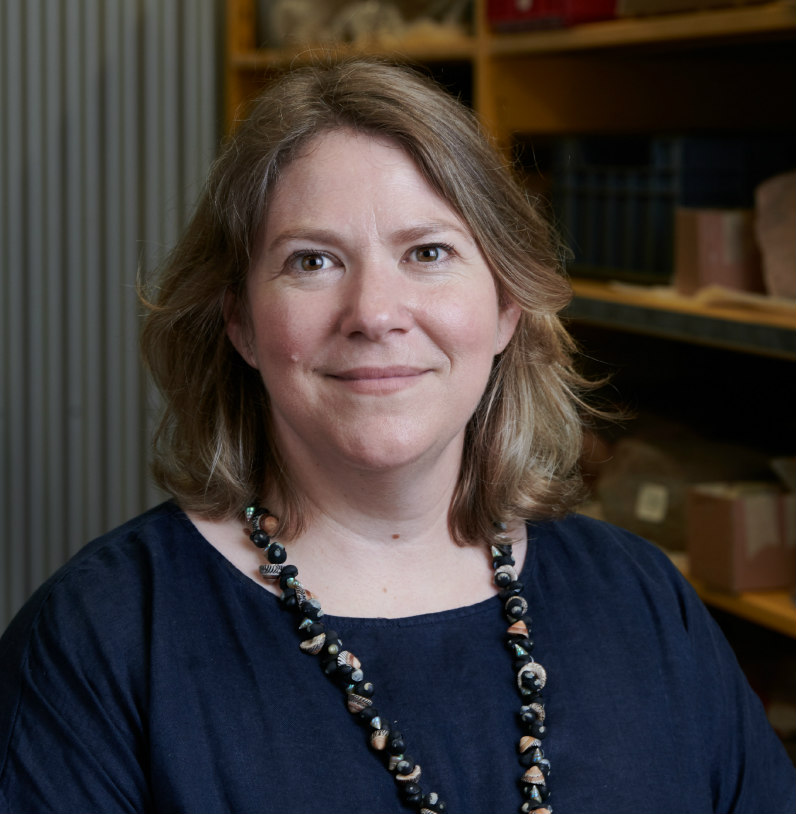
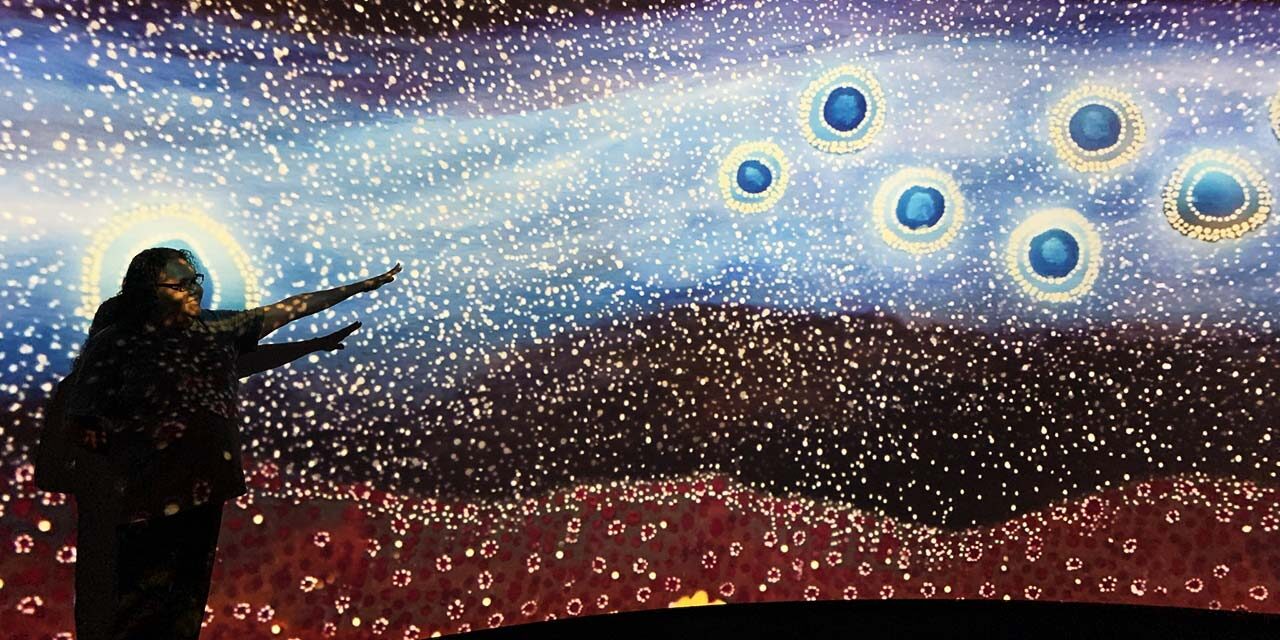
About The Film
We started off with a number of big concepts and ideas that we wanted to cover in this film, as the introductory piece to the whole gallery. The first part of the Origins Gallery is ‘Cosmos’, and so a strong theme of the film is this notion of a ‘shared sky’, that there are many different aspects to thinking about the night sky, depending on your own world view, your cultural background. The sky is something that brings us all together. No matter where you are in WA, when we look up at night, we all see the same stars.
The film was a fantastic collaboration of many talented and skilled individuals. We started with a team of about six curators and project staff from the Museum and sought to work with as many local artists as possible. The script was drafted by gallery lead curator Jessica Brainard, who carried the core vision for the film. The film’s producer Sam Price, is a Perth-based visual artist and brilliant creative. We talked with astrophotographers and researchers, including John Goldsmith and the team at the International Centre for Radio Astronomy Research (ICRAR). We received advice and guidance from the Museum’s Whadjuk working group, but our key cultural adviser on every detail of the film was Whadjuk Nyoongar Elder Dr Noel Nannup. Noel works with the Gingin Observatory (among many other things) where he shares Whadjuk knowledge and stories of the night sky. Noel is also the narrator of this film.
We were grateful to have talented local Whadjuk/Ballardong and Eastern Arrernte artist Jade Doleman lend her hand with some illustrations, as well as Kamsani Bin Salleh, a Nimunburr/Yawuru and Ballardong Nyoongar artist. Gamillaroi illustrator and animator Jake Duczynski created stunning animations of the six seasons. All three artists worked closely with Noel to ensure that the cultural interpretations in their work were appropriate and suitable.
Sonya Edney and Her Painting ‘Seven Sisters’
Sonya’s artwork, her story of the Seven Sisters constellation in the night sky is an important element of the film. It demonstrates so effectively, how Aboriginal observations of the night sky are transformed into knowledge and traditions that are embedded in every aspect of daily life, law and culture. Particularly for visitors who don’t know anything about Western Australia or Aboriginal culture. I think it does that really beautifully and very effectively.
Developing The Presentation
I think there's a huge amount of trust from artists when we approach them about using their artworks. This was particularly true for Sonya. We (curators, producers) try to describe the context in which the artwork is being presented in the gallery and how it's going to be presented in the film. Sonya had to think and imagine what we were describing. We feel very grateful for that trust that Sonya and other artists had in us. Sonya told us, "Yes, please do use my artwork and I believe that you would do the right thing." That’s a big responsibility on us, for an artist to share and allow it to be reinterpreted, and in this instance gently deconstruct and reconstruct it in order to create movement, to animate it. It takes a lot of trust.
Recognising Family Connections
The Origins gallery includes stories and artworks from other Wajarri and Murchison-Gascoyne artists and elders, so we’ve had some Wajarri mob visit the gallery. They came through and they watched the multimedia presentation. They came in and someone asked "Who did that painting?" referring to Sonya’s painting. I think she recognised the style. We told her "That was Sonya Edney." I think they were impressed to see it. It's important that when people come to visit the museum they see familial connections and their stories being told. They see family, friends, country, stories in the museum.
How Visitors Respond
I’ve watched visitors come in and sit down and watch the film and people are transfixed by it. There is a lot of beautiful imagery of the landscapes, night sky and the Milky Way. When Sonya’s painting comes to life on that screen, people's eyes just pop. There is a ‘wow’ response and a bit of a gasp. Kids love it too, they point at the ‘Seven Sisters’ as they move across the screen. Sonya’s painting abounds in energy already, but the simple act of animating the stars, the sisters and the hunter, further emphasises the ‘living’ story it portrays - the painting comes alive before your eyes.
Welcome To Country
We (the Museum, Boola Bardip) is based on Whadjuk Nyoongar country, and there is an interpretive space that welcomes visitors to Whadjuk land near the reception area at the Museum. It was also important for this film to acknowledge that and to ground people within the place where they are now, in Perth, before taking you on a journey around Western Australia.
A lot of imagery in the film is from places that feature in other parts the Origins Gallery, such as the Murchison River, Cape LeGrand and the Cape Leeuwin-Naturaliste area, and with stories and knowledge shared by their respective custodians and Traditional Owners. We've spoken to all of those communities about including imagery of Country in this context, because the film talks about the formation of Country from Aboriginal perspectives. This is also why Sonya’s artwork fits so well, for her, like many others, the sky and land are intimately linked, they are not separate entities. Sonya depicts this in her painting.
The Life of Sonya Edney
This interview is from 2019 with Sonya, where she talks about her life.
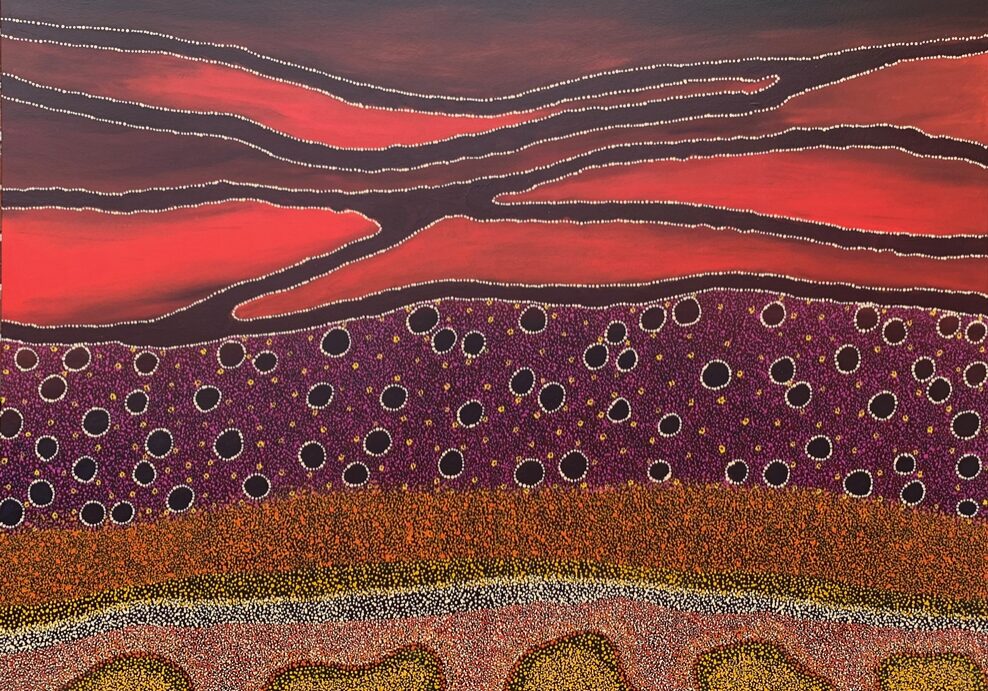

2019 was always going to be a big year for Sonya Edney. She’d just moved from her home town of Carnavon down to establish a life in the city of Perth. She knew there would be a lot of adjustments, especially living so far from her family and friends. She had no idea that this would also be a year of significant personal loss, including the death of her best friend. Sonya turned to her art to find a way through all the grief. In 2109 she launched her first solo exhibition at Japingka Gallery. That exhibition was extremely popular with collectors from all over the world responding to this fresh new style. Sonya talks here about her art, her life and this new career highlight.
My Country
I was born in Carnarvon and grew up in the Gascoyne. I went out bush in Burringurrah community. I lived out there for most of my childhood. I grew up living out in the bush and swimming in the waterholes.
My Art
 I’ve always made art. I was artistic and self-taught. I learnt how to paint and explored all sorts of mediums, watercolours, sketching, charcoal, everything and anything. My uncle, Raymond Edney, is an artist and he encouraged me.
I’ve always made art. I was artistic and self-taught. I learnt how to paint and explored all sorts of mediums, watercolours, sketching, charcoal, everything and anything. My uncle, Raymond Edney, is an artist and he encouraged me.
My Stories
Some of the paintings tell sad stories about my life, about me travelling around and the places I’ve been. You get some sad times and good times. I’ve shown that through my paintings. Mostly I just paint about my own story rather than the Dreaming stories that belong to the people. I just get an idea in my head and then I paint it.
My Year
I only started painting these exhibition works in late 2018. So I think I’ve got about 30 works produced over a six month period. I had so many losses in my family. I wasn’t sure if I was going to paint, but then I did it and it helped me through the grieving side of things. That’s why some of the paintings, the colours are very strong, because of the way I’m feeling.
It was really hard painting when I was grieving at the same time. I ended up just pushing through, now I’m having an exhibition so that’s really good. I would get halfway through some of these works and somebody else would pass away. It was so hard. I’d stop painting for three weeks and then I just get back into it, painting at home or in the gallery.
The Move To Perth
I live in Perth now. I’ve only been here for about a year. It feels unreal that I’m having an exhibition. I’ve been painting all my life, I’ve been in exhibitions with other artists, entered awards and everything. This is my first solo exhibition.
I was struggling and I didn’t know whether to do it or not, but I just kept thinking of my people, you know. My family and friends, they’ll be thinking, “you should keep doing, keep painting.” I’ve got some cousins that live in Perth. But I do miss home. I do go up there, but only for the sad times lately.
First Exhibition
I had my first solo exhibition at Japingka in 2019 and I’m excited, I’ve painted for years. I won an award in Geraldton, I won Artist of the Year for NAIDOC, that was in 2008. This is a very special time for me and I feel very proud of what I’ve been able to create.
How It Feels To Paint
Painting makes me feel good; it relaxes me. I think about a lot of stuff, the things that were on my mind and all things like that. Then after I’ve finished, it’s a good feeling. I get a good feeling and that I did it. I go through the painting, and I enjoy doing the dots. The paintings are about the lands and the sky. The main traditional story I paint is the Seven Sisters and the Emu in the Sky.
Growing Up In The Bush
I grew up out in the bush, and you see a lot of stars, you look at the night sky and tell the stories and everything. So there’s a lot of stories I could paint, but then you’re not allowed to paint those stories. They were very sacred places and things, and you get in trouble if you paint them.
My Painting Routine
I just paint at home. I have a small apartment and I use the lounge room for painting. If I’m working on a bigger canvas I’ll work on the floor or roll the canvas so I can work on one section. I listen to music while I work, I get bored if I don’t paint. Sometimes I just wake up and have this idea and I paint it straight onto the canvas.
Artist Biography
Sonya Edney is a largely self-taught Ingarrda artist born in Carnarvon in the Gascoyne region of Western Australia in 1974. Sonya started painting at home at Burringurrah community, located between the towns of Carnarvon and Meekatharra, where she grew up and attended school of the air. Later she began a Visual Arts course at Carnarvon TAFE and was approached to teach her skills in the local schools for NAIDOC week. Sonya’s father, Ernie Edney (dec.), who was a dogger, was also a musician and Sonya, too, plays musical instruments. She attributes her artistic talents to her family.
Sonya says “Painting inspires me, when I think about home. When I travel and see different country and different scenery, that makes me think about my own country. It takes me back home to where all my inspiration first started out in the bush with my family. Living out in the bush was all about learning where you come from and the stories you were told.”
Sonya has worked in a wide range of mediums from drawing and painting to mosaics, mural painting, basket weaving and silkscreen printing, as well as being involved in the illustrations for Irra Wangga Language Programs. She has travelled widely in Western Australia and has worked at art centres in Geraldton, Carnarvon and Port Hedland.
Her current interests are in painting the country of the upper Gascoyne and out towards Mt Augustus. “It’s red sand and spinifex country and in springtime there are everlastings and other wildflowers and the creeks are running. A lot of stories I’ve got in my head, so it’s good to paint one theme.”
Sonya is currently living in Perth and often paints at Japingka Gallery. Over the last few years, she has lost friends and family members. She says: “Thinking about the style I do now, I am thinking about the land, about home and family. Sometimes when
I’m painting, with the grief I’ve had recently, the painting helps me get through it, although after my nephew passed away, I was too traumatised to be able think properly and it took me two years to be able to pick up a brush. For the last year (2019), I have been able to get back to painting. The feeling that I have, I put into the painting to make the colours, to make it strong. I came in here, to Japingka, with a painting last year and now I’m sitting down painting in the gallery. What inspires me here is being in the gallery looking at all the other artwork, how other artists have done their work.
Once I’ve got the colours organised in my mind, the rest just follows along. It takes a while to get all the background colours done and then it goes from there. I wait, maybe overnight, until the rest of the painting comes to me. Sometimes it is in a dream. Then I start with a colour, then I add some other tints to it to make it darker or lighter, to create movement and to tell the story.” Sonya adds, “The more I paint, the more stories come into my mind that I want to paint, stories from when I was growing up. One story brings back another. It’s an ongoing and compelling process.”
In early October 2020, Sonya went to the Pilbara and Upper Gascoyne for two weeks with a group led by Peter Salmon, who wanted to go back to his Warrinyangga country with his children and grandchildren. His main purpose was to re-enliven his ancestral language, as he is its last living speaker, and pass it down his family line in the hope of preserving it. The trip was reinvigorating for Sonya, too, and a re-connection to her country as they travelled through and stopped at a number of the places where she had lived with her family as a child.
Since Sonya has been painting with Japingka, her stunning artworks, in sell-out exhibitions, have enjoyed a local, national and international audience, finding distant homes in the USA, Europe and Ireland. She currently has two paintings in the inaugural exhibition at the new Western Australian Museum – Boola Bardip.
Exhibitions & Collections
Solo Exhibitions
2019 My Journey through Ingarrda Country, Japingka Gallery, Fremantle WA
2021 Gascoyne Night Skies, Japingka Gallery, Fremantle WA
2022 Recent Paintings, Japingka Gallery, Fremantle WA
2023 Yingarrda Waterholes and Wildflowers, Japingka Gallery, Fremantle WA
2024 Burringurrah Dreaming, Japingka Gallery, Fremantle WA
Selected Group Exhibitions
1997 First Prize, Human Rights Day Art Competition, Gascoyne Arts Council WA
1997 Student Art Exhibition Carnarvon TAFE WA
2002 Derby Art Exhibition, Derby WA
2003 Second Prize, Kimberley Craft Show, Derby WA
2007 NAIDOC Art Exhibition, Exmouth WA
2007 Banggumayigu Walgajulgu, Geraldton Museum, Geraldton WA
2008 Cossack Art Exhibition, Roebourne WA
2008 Connect, QPT, Geraldton WA
2009 Ilgarijiri, GRAG, AIATSIS, Canberra, ACT
2009 Hedland Art Awards, Pt Hedland WA
2009 Ilgarijiri, Curtin University, Perth, WA
2009 Ilgarijiri, GUC, Geraldton WA
2009 NAIDOC, ACDC, Geraldton WA
2009 Ilgarijiri, GRAG, Geraldton WA
2009 OPR Good Art, QV1, Perth WA
2009 Harmony Week, QPT, Geraldton WA
2012 Oakajee Port and Rail: Good Heart Mid-West Aboriginal Art Exhibition, Perth WA
2015 We Call It Home, FORM, Perth WA
2017 The Gurawu Collection, Yamaji Artists, Mundaring Arts Centre, Mundaring WA
2017 Ngang Badimaya Wangga – Yarns with Gami Ollie George, Geraldton Regional Art Gallery,
Geraldton WA
2021 Origins, Boola Bardip – WA Museum, Perth WA
2023 First Lights, Nyinggulu – Fremantle Biennale, Exmouth, WA
Collections
Geraldton Regional Hospital
Telethon Kids Institute, Western Australia
RAC, Western Australia
Boola Bardip – Western Australian Museum, Perth WA
Commissions
Design of one of eleven of the Welcome Rest Stops Across the Pilbara
Residencies
2015 Screen and Lino Printing Residency, Edith Cowan University, Perth WA
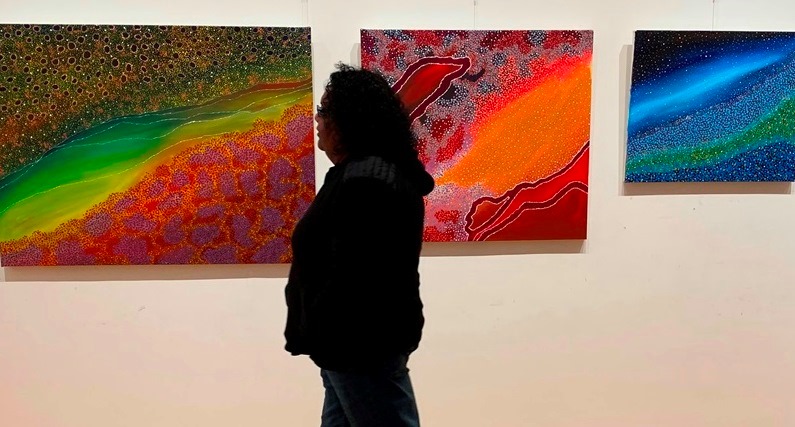
Find out more:
- Sonya Edney Artworks
- Exhibition: Sonya Edney Burringurrah Dreaming 2024
- Exhibition: Sonya Edney Gascoyne Night Skies 2021
- Exhibition: Sonya Edney My Journey Through Ingarrda Country 2019
- Exhibition Walk Through: Sonya Edney My Journey Through Ingarrda Country 2019
Subscribe To Our Email Newsletter
Receive notifications and news about exhibitions and artists.

